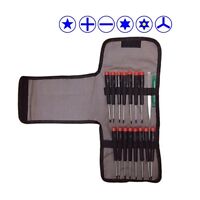
Problem with this, that no mass-producing capitalist would care about, is when such assemblies need to be disassembled and serviced – as anyone dealing with stuck, rusted Phillips screws can attest. Phillips design allowed such screwdrivers to cam-out, before exerting too much tightening torque on the screw (and damaging the material, or the screw). Production lines in the 30s (XX century), especially in the growing automobile industry, did have electric screwdrivers, but very few of those had the option of setting up the tightening torque. I’ll explain implications of this in the next paragraph.

Unlike slotted screws of the time, Phillips allowed one to quickly place a screwdriver in the screw – with the screwdriver automatically sliding in place and self-centering. He understood the advantage of this patent: Year before that, he had started the “ Phillips Screw Company” ( 🙂 ). Phillips and bought the design/patent in 1935, and refined it (final version patent being US. 🙂 Couldn’t get anyone to produce screws and screwdrivers with this patent. But he was probably as good a salesmen, and capitalist, as I am. In 1933 he also patent-protected a matching screwdriver. Thompson invented (and patented under US Pat. How did they come to be, and what is the main problem with them?Ī man named John P. You might have heard of these, they are also known as “cross-recess”, “cross-head”, or “cross-point”. Standards, specifications and dimensions are discussed in the 3rd chapter. Just as little as necessary to understand the current chaos with cross-head screwdrivers. Any additions, or corrections are welcome. Yet, take this article as: “to the best of my knowledge”. Took me a lot of time to figure this out and get all the data. The rest of this post is a rather detailed explanation of the crossed head screwdriver topic, but with no final answer for now, just a few practical examples. Will do my best to explain it in this article.īefore theory, here is my practical demonstration of the problem and how the screwdriver shown above solves it: The Bad news: it’s not simple figuring those out, and trying one out is often the only really safe way to confirm eventually.The Good news: yes, there are more than one manufacturer (and model) of good quality cross-head screwdrivers.Wera Kraftform Stainless 3350 PH 2 Wera Kraftform Stainless 3350 PH 2 – Amazon affiliate linkĭo you have to buy this one, or are there any other good ones? Well, I’ve got some good, and some bad news – which one do you want to read first? 🙂 Those who wish to know how I chose this screwdriver can read the next chapters, but for those who just wish to know which screwdriver has worked very well for me, on both the American Phillips, and on Japanese (bicycle and motorcycle) cross headed screws, this is it (providing Amazon affiliate links for screwdriver pictures and price-comparison): In other words: how can I tell, before trying (and buying), if a screwdriver will work properly with bicycle, motorcycle and other cross head screws?

The goal of this article (and my research for it) was to help myself find a screwdriver that fits well and doesn’t cam-out. How can I find a good Phillips/JIS screwdriver?.Standards of popular cross-tipped screwdrivers.


The difference between Phillips and JIS screwdrivers JIS (Japanese Industrial Standard) screwdriversĢ.3. Alas, if you’ve ever fixed bicycles, motorcycles, or any appliance with cross-head screws, you know how frustrating it gets when your screwdriver just keeps slipping out, especially when you are trying to loosen a stuck screw. Then comes some history, and standards explanation (including JIS), in an attempt to provide a more universal way of recognizing the good, well fitting screwdrivers – and clarify what it’s all about.
#Open macbook screwdriver evay how to#
In this post I’ll explain how to find a cross-head (Phillips) screwdriver that doesn’t slip out when trying to unscrew a tight screw.


 0 kommentar(er)
0 kommentar(er)
